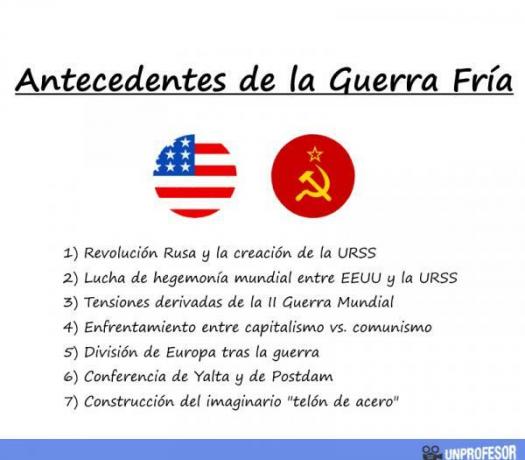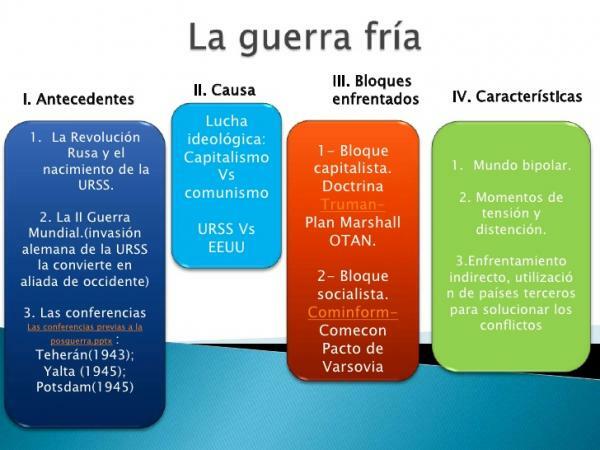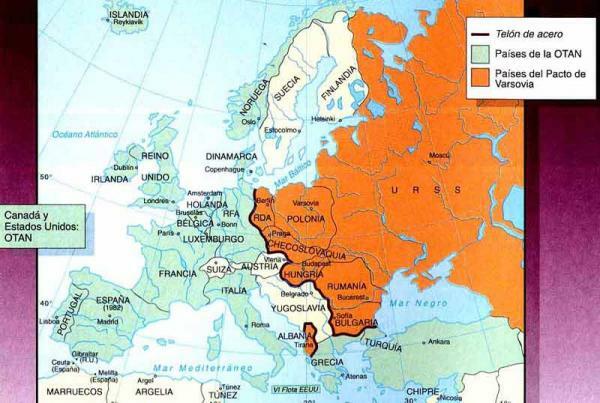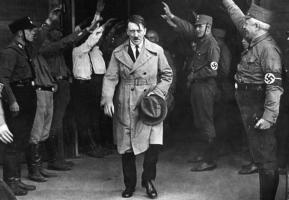Background to the Cold War

Without a doubt, one of the most curious conflicts in history was the Cold WarBeing a conflict that did not confront countries, but faced two ideologies such as capitalism and communism, the first being led by the United States and the second by the USSR. To know the origin of this relevant fact in this lesson from a PROFESSOR, we are going to talk about the Cold War background.
Index
- Russian Revolution
- World War II and the postwar period
- The Conferences: Yalta and Potsdam
- The Iron Curtain
Russian Revolution.
To talk about the antecedents of the Cold War we must comment on events that occurred long before, being the Russian Revolutionone of the most important facts to change the Russian perspective.
The revolution carried out in Russia took place between 1917 and 1923, and they were a series of movements made to overthrow the government of the tsars and to establish a republican Leninist regime with a clear socialist influence. The Bolshevik victory in the war it caused the end of Imperial Russia and the birth of the so-called USSR, a series of unions of republics whose point of union was the belief that the economy should be communist.
The USSR, born of the Russian Revolution, had great relevance for decades, being together with the United States the most relevant nation of the second half of the last century. Although its influence was increasing over the years and even more after the Second World War.
The Second World War and the postwar period.
Of course, another of the antecedents of the Cold War was the Second World War which is considered one of the most momentous events in the history of mankind, therefore that we can talk about it as one of the situations that brought the most consequences on the map European.
Both the United States and the USSR took years to enter the war, with the intervention of both nations essential for the victory of the Allies, but still existing between they great tensions. This was because the Soviets considered that the United States and United Kingdom had left much of the the bulk of the war to the socialists and did not agree with the vision of the Americans about the end of the war.
After the war there was a clash of interests, since the USA considered that the new European map should be based on small capitalist nations, while the USSR wanted that The new states will seek their economic system similar to their own to increase the influence of this form of state throughout the world. planet.

Image: Slideshare
The Conferences: Yalta and Postdam.
After the war and to decide the new European map a series of conferences were held, whose intention was to mark a dialog box so that all the states will look for a common point.
The first was that of Yalta, in which all the allies came together to talk about a way to rebuild Europe after the war but the clash of interests was enormous, causing that no agreement will be reached, and that even the tensions between the regions will increase.
All of this led to a situation where the USSR had occupied the areas of Eastern Europe that they had defended during the war, while The US had occupied western areas that had been recovered by the American troops.
At the same time there was the situation of Germany, which was divided into 4 parts by the allies, the other two allies in the German zone being the British and the French, but the parts Germans of Soviet and American influence, due to the influence that the economic examples of the two great nations had in that area. This situation needed another dialogue table, where the world situation could be decided.
In the Potsdam conference the separation of Germany into four parts, the legislation on Nazi war criminals, and the condition of Japan's surrender. It is thought that everything that happened in these conversations led to the initial stresses of the Cold War.

The Iron Curtain.
The crossing of talks between the US and the USSR in which both nations they accused themselves of seeking to fix their ideology in all the nations of the world for their own benefit, ended up causing the creation of the so-called iron curtain or iron curtain.
This term was used to refer to division by an imaginary line of the states that were in the Capitalist Bloc of the United States and those that were of the Communist Bloc of the USSR. This caused a global separation that would take many decades to disappear, and that even today we can see its consequences.
To understand the differentiation between the states of one block and another, the pacts signed by the countries to understand their relationships and their alliances.
- On the part of the US capitalist bloc we find the signatories of the North Atlantic Treaty that formed the NATO, being its founders some of its founders USA, France, United Kingdom and Italy.
- On the side of the so-called communist bloc we find the signatories of the Warsaw pactSome of its members being the USSR, Czechoslovakia or the German Democratic Republic.
These two blocks were of great relevance during the following years, being the support of all those wars in which each side supported an economic system, some of these being those of Korea and Vietnam.

Image: homohominisacrares.net
If you want to read more articles similar to Background to the Cold War, we recommend that you enter our category of Story.



